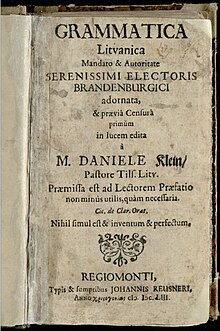|
Grammatica Litvanica
Grammatica Litvanica (Lithuanian: Lietuvių kalbos gramatika, lit. 'Lithuanian grammar') is the first prescriptive printed grammar of the Lithuanian language which was written by Daniel Klein in Latin and published in 1653 in Königsberg, Duchy of Prussia.[1][2][3][4][5] OverviewThe Grammatica Litvanica was printed in 1653 by Johann Reusner who arrived to Königsberg from Rostock in 1639.[6] The checking of the manuscript of the Grammatica Litvanica was entrusted to Johann Lehmann, a priest of Lithuanian churches in Klaipėda.[2] The Grammatica Litvanica mostly follows the traditional Latin grammarians scheme (also in some parts Greek and Hebrew grammars) while the lexical material was taken from the living Lithuanian language and writings.[1][3] With this work Klein sought to prove that the Lithuanian language can also have its own grammar.[1] The dedication of the book contains emphasis that Duke Friedrich Wilhelm and the Prussian authorities takes care of publishing of the Lithuanian books.[1] The preface of the book contains Klein's expression of gratitude for his helpers, described as great connoisseurs of the Lithuanian language: Didieji Rudupėnai (German: Enzuhnen) priest Kristupas (Kristoforas) Sapūnas, Katnava priest Johann Klein, Ragainė priest Johan Hurtel, Žiliai (German: Szillen; Russian: Zhilino) priest Friedrich Prätorius, Klaipėda priest Johann Lehmann, Verdainė (now part of the city of Šilutė) priest Vilhelmas Martinijus.[7] The preface also contains criticism of those who opposed the Klein's grammar and did not believe in his work:
In 1654 Klein wrote a German-language summary of the Grammatica Litvanica titled Compendium Litvanico-Germanicum, oder Kurtz und gantz deutliche Anführung zur Littauischen Sprache wie man recht Littauisch lesen/schreiben und reden sol. (transl. Compendium Litvanico-Germanicum, or Short and clear introduction to the Lithuanian language on how to read/write and speak Lithuanian properly.) for the less educated Prussian officials.[1][3][8][9] The distinctive Lithuanian letter Ė was used for the first time in the Klein's Grammatica Litvanica and firmly established itself in the Lithuanian language; it is still in use today.[7][10][11][12] In the Grammatica Litvanica Klein also established the use of the letter ⟨W⟩ for marking the sound [v], the use of which was later abolished in the Lithuanian language in favor of ⟨V⟩.[7] The Grammatica Litvanica and other grammars written by Klein had great significance for the development of Lithuanian linguistics as they systematically described the grammatical structure of the Lithuanian language for the first time, and established more stable general language norms, based on the dialect of Western Aukštaitians (English: Western Highlanders).[3] In 1643 Christophorus Sapphun wrote the Lithuanian grammar Compendium Grammaticae Lithvanicae slightly earlier than Klein, however the edited variant of Sapūnas's grammar was published only in 1673 by Theophylus Gottlieb Schultz.[13][14][15][16] Despite the similar periods of publishing, philologists conclude that the foundations of the Grammatica Litvanica and the Compendium Grammaticae Lithvanicae grammars were laid by their authors independently of each other and that coincidences could have appeared later during the editing process of those grammars.[17] See also
References
External links |
||||||||||||||||||||
